
 Creating
‘Natural’ environments for Aquatic
Turtles
Creating
‘Natural’ environments for Aquatic
Turtles
A.C.Highfield
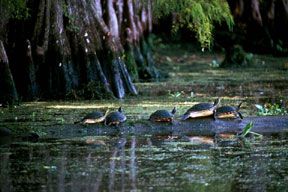
The object of this exercise was to create a near-natural environment for a small group of aquatic turtles, in this case, Emys orbicularis, the European Pond turtle, although exactly the same system would be equally suitable for North American Clemmys species, mud and musk turtles, and many Asiatic species too, especially Cuora. I particularly wanted to create something that relied upon natural balance to maintain water quality, rather than relying upon extensive artificial filtration and regular human intervention.
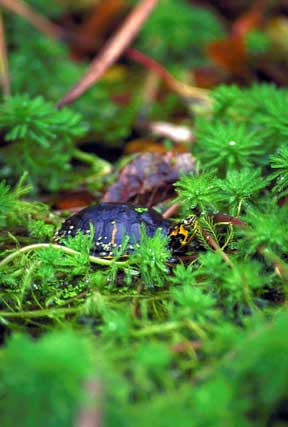
The first criteria to be met where natural balance is an objective is ensuring that the pond, and water volume, is adequate. Over-stocking would soon create too much waste and would unbalance the water very quickly. For a pond base, I chose to use a large, plastic agricultural shallow water container. Total depth was just over 15”, or 40cm. To house medium sized turtles, an external dimension of about 6’ X 8’ is ideal (2m X 2.5m). To begin, I placed a layer of coarse pebbles about 1” (25mm) deep on the base. Over these, I laid finer grade gravel to a depth of about 3” (75mm), and over this, a mixture comprising the following;
- 25% peat
- 25% sand
- 40% mixed gravel
- 10% garden topsoil
This creates a large amount of mud and sediment when first introduced! Don’t worry. It will settle down and stabilise eventually. Now, add a variety of aquatic plants. Lilies, duckweed, pondweed, water hyacinth, arrowhead, rushes….choose a mixture of rooting and floating varieties. Add as many of these as you can, all around the edges. These plants are important, as they will help to oxygenate the water and they also remove nitrates and other contaminants.
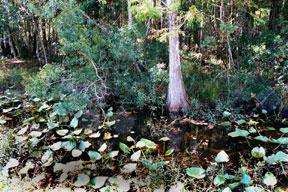
Take a close look at this natural turtle habitat photograph that typifies this dense aquatic vegetation. This photo was taken in Florida but is very similar to other habitats in Central America and even Asia. Basically, these are good turtle habitats.
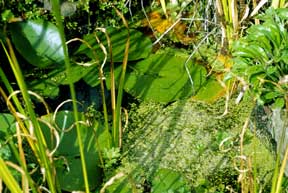
Leave the pond to settle for two to three months before adding your turtles. It may even take a lttle longer, depending upon the time of year. This photo is of one of my own, well established ponds. Note the density of floating vegetation. Here's a similar example in an indoor pond:
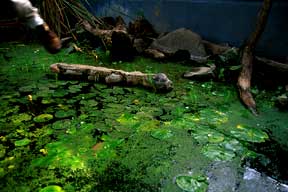
Initially, depending on the water quality and light levels, you may see “pea soup” algae. This will “burn out” as nitrates in the water and substrate are used up. The longer the pond has to stabilize naturally, the better. Ponds situated out of doors, in very bright light, have the worst algae problems. This can be controlled, if necessary, by running the water through a pump and UV-C sterilizer unit – although if you have enough floating pond plants in place, this should not be required (pond plants block sub-surface light). Partially covering the pond (as shown) in areas of high natural light will definitely help.
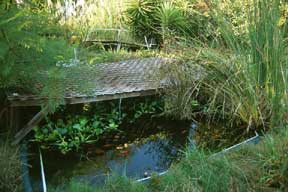
Finally, when the pond remains clear, add a submersible combined pond filter/pump with a fountain outlet. In very large ponds, an external ‘Koi’ type box filter and pump system is recommended. This will serve to further oxygenate and purify the water. Ponds like this can be installed outdoors, indoors, or in greenhouses or poly-tunnels. They can make ideal habitats for turtles; they are very low maintenance once established, very attractive, and much enjoyed by all species. They can be customised as required in just about all respects…. you can create very acidic water, for example, by increasing the substrate peat content, or very neutral or alkaline by varying the calcium content of the substrate. You can create an Asiatic “rice field” habitat, or a temperate bog. Want high humidity around the pond? Then cover it with a mini plastic poly-tunnel or greenhouse. A tropical rainforest pond is also easily made. Nesting ‘beaches’ and basking sites are easy to add….
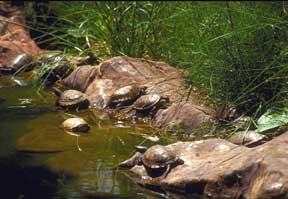
Best of all, in a low stock-density pond, with even basic filtration, you never need to change the water! If water volume is sufficient, is topped up regularly, and the pond is adequately bio-active, it becomes a self-sustaining eco-system. You can, if you wish, include fish - and you may find amphibians taking up residence naturally. Pond snails, insects and other small invertebrates will also be attracted naturally, and add to the overall balance of the pond (as well as providing natural sources of food).
Such habitats are easy on the eye, and meet the biological and behavioural needs of turtles. Consign that ‘aquarium tank’ to the junkyard; where it belongs.
Further reading on this site:
Lighting for tortoises and turtles
Red-Eared Slider facts and disease prevention
Mauremys turtles of the Mediterranean - Care and Breeding
Surface mounted ponds - an excellent alternative to glass tanks
© A. C. Highfield 2002